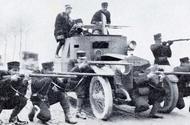Belgian forces pioneered the use of armoured cars
Cars were used for all kinds of purposes during the Great War – we took a look at exactly what
While the start of World War II is still in living memory, WW1 has been consigned to history; while most know about the Panzer and the Spitfire, the Minerva and the Taube have become quite obscure; and while we know how it played out, we’re viewing it in hindsight and through distortion caused by subsequent developments.
Let us, then, go back 109 years to arrive as Autocar assessed the roles that automotive vehicles were enacting in this whole new kind of warfare.
Within days of Britain declaring war on Germany, we printed a form that readers could submit to ‘lend’ their cars to the army; and by September, we were giving advice on how to maintain and prepare cars for this purpose.
We noted that Belgium had thus far made best use of requisitioned cars, to carry ammunition, food and more, having few vans. Soon it began removing car bodies and refitting chassis with open-truck, ambulance and armoured ones.
We were particularly impressed by a form of ambulance (also used by the French) that contained four stretchers mounted on a revolving wooden frame, such that an empty one would always be behind the canvas covering’s side entrance.
Minerva of Antwerp was the primary maker of armoured cars, making Belgium the first nation to deploy them in the war. Fitting a tourer chassis with a body of 5mm-thick steel and a forward-facing light machine gun created “one of the most deadly weapons”, with “its speed and easy manipulation enabling it to make rushes, short, sharp attacks, and retire quickly”.
“These qualities of extreme mobility more than make up for the fact that the light, thin armour is not bulletproof at short range,” claimed our contact at Minerva, adding that it was surely superior to the “heavy-plated high-speed lorries” favoured by neutral Italy.
Germany had plenty of fighting cars too (plus lots of lorries). Our man had been struck with a large, bullet-hole-ridden Mercedes that had been captured – but also relayed a story of enemy success: Germans had dressed as Belgians, driven into Antwerp and calmly left armed with information.
Another very useful innovation came from the French: a De Dion-Bouton lorry with searchlights mounted atop it and trailers towed behind, power coming from the engine via a dynamo and cables.
Of course, combustion engines had also given rise to aeroplanes, and just 10 years after the very first heavier-than-air flight, men were shooting at each other in the skies.
Victory was very hard to achieve with a pistol or rifle (the propeller-synchronisation gear for a machine gun wasn’t invented until 1915) and bombing – by hand! – also wasn’t practical yet, as 4000ft was needed for safety from rifle fire. Therefore recon and the downing of airships were planes’ primary purposes.
“The Royal Flying Corps’ skill, energy and perseverance has been beyond all praise,” British Expeditionary Force commander Sir John French told parliament. “They have furnished me with most complete and accurate information, which has been of incalculable value in the conduct of operations. Further, by actually fighting in the air, they have succeeded in destroying five of the enemy’s machines.”
Surely of greater concern to the Germans, though, was their oil shortage, the Allies blocking ships from the Americas and Asia. This situation would persist, while the Galician and Romanian oil fields were unable to quench the Central Powers’ thirst.
One of our columnists, Owen John, had volunteered to fight and reported from his training camp with optimism and patriotism.
“I have received several letters from [readers] informing me that I have no business to use my pen to persuade those who don’t want to fight to go and do what they don’t want to. All I know is that it seems to me an omission of duty not to offer to help defend one’s country (and, incidentally, oneself if the necessity arises),” he wrote.
“I believe this war is going to be the end of Kaiserism and all the devilish creed it implies. If this comes true, how glorious will be the fame of those who died in the killing of it.”







